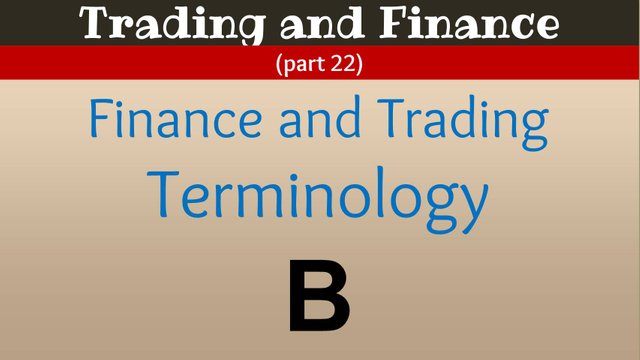Basics of Trading and Finance (Part 22) : Trading and Finance Terminology : B (19-40)
Intro
IntroAs a moderator of the Tron Fan Club community, I regularly write various tutorials on crypto blockchain and Tron related matters. The main purpose of these tutorials is to make our new users aware of these topics. In continuation of that I am writing tutorials on trading and finance. Hope you can easily learn some details of trading and finance through this tutorial series.

19. Backlog: It's like a to-do list that has piled up. Imagine you've got a bunch of tasks you haven't completed yet—that's a backlog. In business, it's the work or orders that haven't been fulfilled yet. If a software company is behind on completing its tasks, it has a backlog of features to develop.
20. Base Currency: In a trading pair (like BTC/USD), the base currency is the first one listed. It’s the one being measured in terms of the second currency. In BTC/USD, BTC is the base currency, and USD is the quote currency.
21. Base Rate: It’s the basic interest rate set by central banks that influences lending rates. If the central bank sets the base rate at 5%, that impacts how much interest banks charge when you take a loan.
22. Basket: In finance, it means a collection of different assets. A basket of cryptocurrencies might include Bitcoin, Ethereum, and Tron etc.
23. Bear Market: This is when prices in the market are falling, and there’s a lot of pessimism. During a bear market, the prices of stocks or crypto could drop significantly, and investors might feel nervous.
24. Benchmark: A standard or reference point you compare things to. The S&P 500 index is often used as a benchmark to compare how other investments are performing.
25. Bid Rate/Price: This is the price someone is willing to pay to buy an asset. If the bid price for Bitcoin is $30,000, that’s the highest amount someone is currently offering to buy it for.
26. Bitcoin: A type of digital currency (cryptocurrency) that’s decentralized and not controlled by any government or bank.
27. Block: A chunk of data that stores transaction records in a blockchain. When you send Bitcoin to someone, that transaction gets added to a block.
28. Block Explorer: A tool to look at transactions happening on a blockchain.
29. Block Producer: These are the people or entities responsible for creating new blocks in some blockchains.
30. Block Size: The amount of data that can be stored in a block. Bitcoin’s block size is 1MB.
31. Blockchain: A digital ledger that records transactions across many computers.
32. Bond: A loan you give to a company or government, and they pay you interest in return. You buy a bond from a company, and they agree to pay you back with interest after a certain number of years.
33. Book Value: The value of a company’s assets minus its liabilities, according to its balance sheet.
34. Bot: A software program that automatically performs tasks. A trading bot can buy and sell cryptocurrencies automatically based on market conditions.
35. Bounty: A reward for completing a specific task, often in the crypto world. A blockchain project might offer a bounty for finding bugs in their code.
36. Broker: A person or firm that buys and sells assets on your behalf.
37. Bubble: A situation where asset prices rise much higher than their actual value.
38. BUIDL: A play on "build," meaning to focus on building blockchain projects rather than just speculating. In a bear market, smart investors say “BUIDL” to focus on creating long-term value instead of short-term profit.
39. Bull Run: A period when the prices of assets are going up consistently.
40. Bull Trap: When prices rise and trick investors into thinking a bull market has begun, but then the prices fall again.


Click to Join our Discord Server
Upvoted! Thank you for supporting witness @jswit.